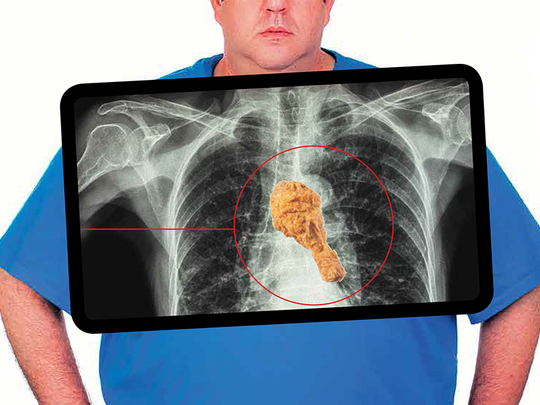
Dubai: Three years from now, hopefully, supermarket shelves around the world will be laden with good news.
This is because, last month, the US Food and Drug Administration (FDA) finally ruled that Partially Hydrogenated Oils (PHOs), the primary dietary source of artificial trans fats in processed foods, are not “generally recognised as safe” (GRAS) for use in food and has given the food industry a compliance window of three years to reformulate products with other permissible food additives.
Clearly, it was a triumph of sorts for the campaigners against the use of PHOs in the food industry.
This means that by 2018, we might find food products in supermarket aisles that may be free of trans fats. But will this really happen? The truth is, given the decades of food economics and consumer food habits, it seems to be a tall order to completely eliminate PHOs from our foods.
However, we also need to recognise a stark reality: trans fats are one of the main causes of the staggering rise in lifestyle diseases. These stealthy compounds raise triglyceride levels, trigger inflammation in the body and clog arteries with ‘bad’ cholesterol, a triple whammy that has helped cardiovascular disease (CVD) become the number one killer in the world after road accidents.
Seen in this light, the FDA ruling comes as a much-needed reversal of the dark tide of lifestyle diseases that has created a health crisis of unprecedented proportions for the world’s population over the last 50 years.
First, do you, as a consumer, know where trans fats lurk? Well, in just about every packaged food you eat. In all the lip-smacking cookies, chips, sauces, ketchups, frozen meals (heat-and-eat variety, including frozen pizzas), ice-cream, cakes and sausages, among many other foods. All these goodies have trans fats in them, and consuming them fast tracks you to cardiovascular diseases.
Dr Nasim Ashraf, American Board-certified Internal and Integrative Medicine specialist and CEO of the Abu Dhabi-based DNA Health Corp, told Gulf News: “Basically, trans fats also called trans fatty acids. These are created when vegetable cooking oils are partially hydrogenated. [Hydrogenation is a process in which liquid oils are put through a chemical procedure that enables them to stay hard at room temperature.] These are called artificial trans fats.”
Why is this done?
“Because the oil is then easy to use and reuse,” says Dr Ashraf. It becomes an economically viable commodity. Hydrogenation also helps the oil make the food it is cooked in or added to have a desirable taste and texture.
The FDA’s main fight is against the artificial trans fatty acids that the PHOs contain and that are known to cause considerable harm due to overuse. “What we need to guard against is the PHOs [from both cottonseed and soybean oils] the food manufactures use widely and these are not generally recognised as safe (GRAS) for consumption,” says Dr Ashraf.
Why are trans fats likened to a slow poison?
Dr Ashraf explains: “[Due to the change in their chemical structure] trans fats are bad for our health as they raise the levels of LDL (Low Density Lipoprotein) Cholesterol — the bad cholesterol and lower the level of HDL (High Density Lipoprotein) cholesterol, which is the good cholesterol. This can increase the risk of heart attacks, strokes and diabetes. The American Heart Association (AHA) recommends limiting your consumption of saturated fats to less than 10 per cent of your daily calories. A new study indicates that trans fats are also known to cause memory decline and cognitive impairment.”
Instead of oils and fats which are partially hydrogenated, it is better to use olive oil and peanut oil as they have mono unsaturated fats which are healthier. Traditional ghee (clarified butter) is also much better in small quantities compared to margarine and partially hydrogenated cooking oils.
“In general, we should reduce and limit intake of saturated fats and partially hydrogenated fats and use more mono and poly unsaturated fats,” said Dr Ashraf.
Are trans fats a necessary evil?
Beyond the world of hydrogenated oil-based foods, the fact is that trans fats are also found to occur naturally in the intestines of certain animals such as bovine animals and sheep. Compounds such as vaccenyl and conjugated linoleyl acid are produced in very small quantities in the intestines of these animals and are, therefore, found in their meat and milk. But the quantity is so small that it’s insignificant.
Juilot Vinolia, clinical nutritionist at Medeor 24/7 hospital in Dubai, explained why it is a challenging task to escape the trans fatty acid trap. “Traditionally, fat and sugar are used as a preservative in the food industry for many years as this is what gives these products a long shelf life. Some brands of meat burgers, for instance, can be preserved in the frozen state for up to four years. Any processed or packaged food with a shelf life of more than three months is likely to have trans fat in it. The worst kind of product that contains trans fat are processed sausages, which mothers lovingly feed their children [as a snack or part of a meal]. They have a good percentage of trans fatty acids and as a staple food for children are highly avoidable.”
Other ways people can cut down on trans fats in their diet is by minimising barbecues, as the meat and chicken cooked over open wood and charcoal fires can transform the naturally occurring trans fats in animal products and make them more harmful to your health.”
It also pays to assess the amount of food you are consuming that comes in tetra packs.
Much of what is packaged or put into tetra-packs contains trans fats in some amount, says Vinolia. “People switch from normal milk to creamers which contain a certain percentage of trans fats. Just consider the number of cups of tea and coffee you might be having in a day and the amount of trans fats you are adding to your food even while you think you are drinking healthy. Take the low-calorie crackers which we presume are healthy. They contain 0.5gm per serving of trans fat. If you were to have more than two or three, you would be consuming too much trans fat. The biggest culprits are the zero-fat, zero-sugar products. When they remove the natural fat, they add trans fat and they add artificial sweeteners to enhance taste, chemically altering the nutrition of a product. You need to read labels and make sure that trans fat in any product is less than 5-7 per cent per serving of the product. So, if a product contains 5gm of trans fat, per 100gm of the product will have 0.5 per cent of trans fat. In a day, we often reach out for biscuits, chips, ice-cream and increase our consumption of this harmful additive to more than 10 per cent of our daily calorie intake.”
Will the FDA ruling have a legal implication?
The FDA has given the food industry a three-year window for compliance. However, when it comes into effect, it will have a bearing on the food industry. Dr Ashraf said: “The FDA’s final ruling on trans fats means, within three years, all artificial trans fats will have to be totally removed from all products and in the preparation of food reusing old oil in restaurants. In 2013, FDA had issued a preliminary determination that trans fats were not generally regarded as safe. This had a loophole. If concentration of trans fats was up to 0.5gm per serving, manufacturers could still label it as zero. And restaurants could use and reuse cooking oils with trans fats. Now, all this will stop by 2018.”
Will it really?
Cynics say it is not really possible to make any of the packaged food without PHOs (Partially Hydrogetaed Oils) in small amounts. When the order is enforced, the food industry willl have to make the paradigm shift and look for healthier alternatives. For one, it will have to get over its fixation for food that has a shelf life of beyond three months and use other food additives that are GRAS, such as permissible PHOs made from rape seed and menhaden oil that the FDA says can be used in small amounts. The decision of the US food industry to make this switch is likely to have a worldwide impact as many countries follow FDA guidelines. Besides, in countries like the UAE, many US food products are imported and consumers here have direct access to them in supermarkets. Any healthy change in the food product will impact UAE consumers who habitually consume US proucts. Despite all the checks and balances in place, as consumers, we need to be more aware and minimise consumption of packaged food, opt for fresh food items, avoid foodstuff with a long shelf life and cut down on eating out in restaurants.












